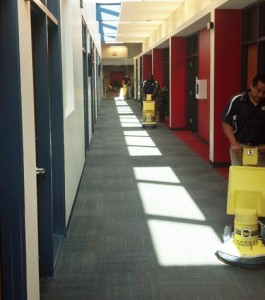The question: Why do I keep getting beat on my commercial bids?
Steve’s answer: Work your numbers, get efficient and increase your “sales funnel”!
Hi Steve,

We just put in a bid for a local restaurant. My husband tried to stay in the middle of the “going rate” for square footage cost. (He called a couple of local cleaning suppliers to see what going rate was.) The owner of the restaurant said if our bid was close he would switch to us. (He has 4 local restaurants so I was super excited!) BUT Steve, their carpet cleaner is doing it for .07 cents per foot! This is one half of what our bid was for!
So Steve, should we bite the bullet and bid commercial carpet cleaning at .07 cents per foot ? (My husband bid at .13 on the restaurant.) I really want (and feel we need!) to get some commercial carpet cleaning accounts. The regular cash flow could really help us and especially in the winter. But my husband is too proud to cut his prices. (.07 per foot! Seriously?) So he has lost his motivation. (This problem has even affected our marriage since we’re hardly speaking to each other now!)
Puzzled and a Bit Depressed in the Midwest
You should focus on building commercial contract “cleaning routes”.
Thanks for the letter, Puzzled. Here is the good news: You are absolutely correct to focus on building commercial contract “cleaning routes”. These regular accounts will smooth out your cash flow, let you hire part time employees to make you big profits AND greatly increase the value of your business! (I wasn’t a big company and yet we could count on over $35,000.00 a month coming in thanks to our regular commercial carpet cleaning routes!)
And yet, I do understand your concern on trying to charge the low “going cents per foot rate”. But Puzzled, may I say you are approaching this all wrong? Listen carefully here: IT DOESN’T MATTER “WHAT THE GOING RATE IS”! What counts is:
- What your costs are plus…
- How much you want to clear per hour personally after paying the “costs” in A above AND…
- Any additional costs to factor in such as drive time or set up costs all divided by …
- What your production rate will be per hour on any given job equals… (NOTE: Do you even know what your production rate is on any given carpet/soiling situation? If not, PLEASE download my free Production/Pricing Analysis Log HERE and START USING IT!)
- TA-DA! Your charge per square foot!
If I was a math whiz instead of a rug-sucker the mathematical equation would look something like this: (a + b+c) ÷ d = e (your cost per sq. ft.) But now let’s focus on your big question:
“Is that how some companies make it big? Is it by going in at bottom prices and cleaning commercial carpet but then eventually it eventually pays off somehow?”
My reply? “Maybe … for awhile. But long term NO ONE can ignore the immutable law of economics profiled in my formula above!”
Listen carefully here… You cannot sell for less than your costs over a long period without paying the price. (Sure, you can “get big” by under bidding the market. But that is just the business version of slitting your wrists and slowly bleeding to death!)

So how CAN a company successfully operate at .07 cents per foot? One or more likely is in play with your successful local competition:
- Super efficient/ high quality. Your competitors may have discovered “encapsulation technology” . (With the right equipment, account layout and right type of carpet you can absolutely make BIG MONEY at 7 cents per foot!)
- Super fast/ low quality. Simply put, many larger property managers and institutional accounts don’t even care if you do a “good job”. So a company like this can slide by for years on some accounts doing bad work while pocketing big profits.
- Super low pay. Many prospective employees are desperate right now and will accept even low paid work. (Labor is always your biggest line item expense- lower labor costs equals lower pricing/higher profits.)
- Super aggressive. These people probably have an aggressive sales force and marketing program in place. So sure, they will lose work due to #2 and #3 above. But IF they have a stream of new “replacement” accounts no problem! In fact, constantly losing (and replacing) work is likely part of their business plan!
- Super big. A really huge company can “amortize” much of their fixed overhead over a much larger quantity of work which many allow them to bid lower or more likely is one of more of the above factors plus they may be …
- “SUPER STUPID!” Even big companies can coast along for years as the old saying goes, “Losing money on every job but making it up in volume”. Simply put, they may not even know they are losing money! (As a smaller company you can’t afford to do this!) 🙂
So what can you do, Puzzled? (By the way, I’m not promoting any of the “SUPER” business approaches above!) So a few options for you …

- Get faster/ get more efficient with production. The Cimex Cyclone just may change your life! (It did for Jeff Cutshall HERE!) If “you can’t beat ’em you may want to join ’em” by competing at low cents per foot prices and encapsulation with the Cimex will still let you make a ton of money at .07!) Download our free SFS Special Report on Building Encapsulation Routes HERE. (NOTE: Check out the Cimex Cyclone HERE. Or watch this video of Big Billy Yeadon with the Cimex HERE. A Cimex Cyclone will easily average 2,000 feet per hour cleaning commercial carpet even with an old guy running it!)
- Quit setting your pricing emotionally. After ruthlessly cutting your overhead (which needs to be done anyway) and increasing your production per hour numbers (ditto on the “needs to be done” reminder) just look how long each job will take and you will easily arrive at your cents per foot price.
- Do REGULAR selling for commercial cleaning. Set up a consistent marketing program for commercial work. Commercial selling is a game of numbers so you must increase the size of your “sales funnel”. Remember, you WILL lose work no matter how good your quality is. Accept this fact, keep a stream of new accounts coming in and move on.
Let me know how you are doing out there. After all, we are all in this together and Jon-Don, your SFS team and I all want to help. You CAN beat the “big boys” at their own game!
Steve
PS By the way, my Commercial Carpet Analysis form will be a big help in bidding and selling regular contract commercial carpet cleaning.


Steve is right on the money here!!
We do commercial carpet cleaning by the man hour after figuring in our cost (breakeven) and our desired profits. We do hamburgers chains and jewelry stores in malls and we get a flat $50 per hour per man. Nice profits!!
We upsell our quality and it works. We had our accounts for over five years.
EXACTLY, Paul. Know your costs and know what profit you need to make. This stuff isn’t “rocket science”! 🙂
Thanks for chiming in!
Steve
PS Congratulations on keeping your accounts long term. However, even the best company will have “customer erosion”. That is why it is so important to have an ongoing sales strategy in place for commercial work.
hI, i JUST BID A COMMERCIAL CLEANING JOB. 50,000 SQ FT .8 CENTS PER. WHAT IS THE FORMULA FIGURE OUT TOTAL. THE CUSTOMER IS TELLING ME $2003.00M A MO.
Thanks for writing in and we want to help. I (and all your fellow SFS readers) will need to know what method you are using, type of carpet, soiling levels and most important what obstructions are you dealing with? (Furniture to be moved, small rooms or is it all one big space?) We also need to know any set-up/access problems, hours you can do the work, etc. Maybe most importantly how long will it take you to do the job AND how much do you need to make per hour. (If you don’t have these numbers then you need our free Pricing/Production Analysis Log.) THEN we can start cooking!
Steve
I’m also curious where this “$2003.00 per month” number came from? Is this what your customer says they are paying per month to clean ALL 50,000 square feet? (Remember that people throw around numbers but just because a building contains 50,000 feet and is supposedly all carpeted I’ll guarantee you that it won’t have 50,000′ of carpet!)
I was just wondering what the going rates are today (2017)
My commercial carpet cleaning company was recently acquired by another carpet cleaning company, and the new owner does not like that we were doing some of our accounts in the 6 cents per foot range.
Most of the jobs priced at this rate are in the 20,000-30,000 SF range, in nicely kept professional office environments. We were always able to achieve 20-25% labor on these jobs in the past, but now that we have different crews going to these jobs (who were more residential cleaning oriented) – they are working a lot slower and spending a lot more time there than my old crews used to.
My boss wants to raise prices (they normally charge 27-36 cents per foot), but most of their commercial work is small accounts. I am afraid if they raise the price to 8 cents a foot or more, our biggest customers will go elsewhere or consider in house cleaning.
Any suggestions?
I’m a huge proponent of “charging more”, Jack. Why? Because MORE profit is always better than LESS profit! 🙂 (DUH, Steve!) BUT my “Raise your prices every year” harangue is focused toward the residential cleaning sector, not commercial contract cleaning clients!
The new owner of your company needs to understand that contract commercial carpet cleaning is a totally different type of business than residential cleaning! If you folks go in and willy-nilly raise prices across the board on longstanding commercial clients the first thing they will do is “put the job out to bid”. (Who can blame them?)
Instead, I would urge the new owner a) to increase production on the accounts (commercial is all about “production” so what happened to your previous crews?) and b) use this free SFS Production/ Price Analysis form to unemotionally decide if the account at its current pricing is profitable. If so, LEAVE IT ALONE!
NOTE: On most regular commercial cleaning accounts you really don’t want to be “noticed”. Instead, it is much better to just “blend into the woodwork”. And there is no worse way to be noticed than raise your prices!
I tell every SFS class, “Never make business decisions emotionally!” And it sounds like this is what the new owner of your company may be doing! Best wishes!